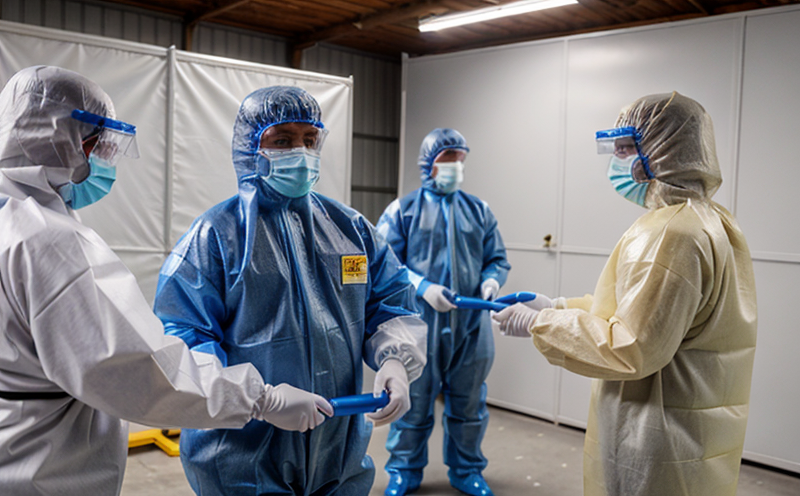NFPA 1999 Emergency medical protective suits Requirements and testing
The NFPA 1999 standard specifies the performance requirements for emergency medical protective clothing used in various medical emergencies. These suits are designed to provide protection against a range of hazards encountered by first responders, including chemical, biological, radiological, and nuclear (CBRN) threats. The NFPA 1999 certification is essential for ensuring that the suits meet rigorous safety standards set forth by the National Fire Protection Association.
Protective clothing plays a critical role in safeguarding individuals who work in environments where they could be exposed to harmful substances or situations. Compliance with NFPA 1999 ensures that these garments are engineered and tested to withstand potential risks, thereby protecting the wearer from physical harm. This standard is particularly important for emergency medical personnel whose job involves direct contact with hazardous materials.
The testing process for NFPA 1999 certified suits includes several stringent requirements aimed at evaluating the suit's resistance to various hazards. These include chemical permeation tests, flame resistance assessments, and durability evaluations under simulated use conditions. The goal is to ensure that each suit meets or exceeds the specified performance criteria outlined in the standard.
Chemical permeation testing assesses how effectively the suit protects against liquid chemicals by measuring the rate at which these substances can penetrate through the fabric. Flame resistance tests determine whether the material will continue burning after being exposed to a flame, ensuring that the wearer is protected even if fire breaks out. Durability assessments evaluate how well the suit holds up over time and during repeated use.
For R&D engineers and quality managers involved in developing or procuring these protective garments, understanding NFPA 1999 requirements is crucial. This knowledge helps ensure that products meet regulatory expectations and can be used safely by healthcare professionals. By adhering to this standard, manufacturers contribute to enhancing the overall safety levels within emergency response teams.
Compliance officers responsible for ensuring adherence to industry regulations also benefit from familiarity with NFPA 1999 standards. They play a key role in implementing measures that guarantee compliance across all aspects of product development and manufacturing processes. Understanding these requirements allows them to make informed decisions about sourcing materials, selecting appropriate designs, and implementing quality control protocols.
In summary, NFPA 1999 certification represents an important benchmark for emergency medical protective suits designed to protect healthcare workers from various hazards they may encounter during their duties. Meeting this standard ensures that the suits are reliable, safe, and effective in real-world scenarios.
Applied Standards
| Standard | Description |
|---|---|
| NFPA 1999 | The standard specifies the performance requirements for emergency medical protective clothing used in various medical emergencies. |
| ISO 20695-3:2017 | Defines the method of test and specification for liquid barrier properties of textiles. |
| ASTM F1670 | Provides guidelines on how to perform a flame resistance test on fabrics used in protective clothing. |
| EN ISO 24098:2023 | Establishes requirements for the performance of chemical protective clothing. |
Benefits
Complying with NFPA 1999 standards offers numerous advantages to manufacturers, suppliers, and users of emergency medical protective suits. Firstly, it ensures high levels of safety and reliability for healthcare workers by providing robust protection against hazardous materials.
Secondly, adherence to this standard helps maintain a consistent quality level across different products, which is essential given the critical nature of the industry involved. Thirdly, meeting these requirements enhances brand reputation among customers who value safety and performance in their purchasing decisions.
Additionally, compliance with NFPA 1999 facilitates smoother regulatory processes by simplifying documentation and audits for organizations operating within regulated environments. It also encourages innovation through continuous improvement efforts aimed at exceeding basic standards set forth by the standard.
Lastly, businesses that adopt this certification enjoy increased market access opportunities as they demonstrate their commitment to quality and safety standards recognized globally. Overall, NFPA 1999 represents a valuable tool for promoting excellence in emergency medical protective clothing manufacturing practices.
Use Cases and Application Examples
In the context of NFPA 1999 certification, there are several typical use cases where these suits find application. One common scenario involves first responders who need protection while handling patients exposed to infectious diseases or other hazardous materials.
A second example includes healthcare workers involved in decontamination procedures following incidents involving chemical spills or biological contamination events. Such professionals must wear protective gear that can withstand repeated exposure without compromising on its integrity.
Another relevant use case pertains to paramedics working at disaster sites where they might encounter multiple types of hazardous substances simultaneously. In such high-risk situations, NFPA 1999 certified suits provide peace of mind knowing that the suit has been rigorously tested and proven effective against potential threats.
Moreover, the standard is applicable beyond just medical settings; it extends to other sectors like industrial hygiene where personnel may need additional protection during their daily activities. By leveraging this certification, employers can enhance worker safety while adhering to strict regulatory requirements.
To summarize, NFPA 1999 certified suits offer comprehensive protection tailored specifically for emergency medical professionals and others who work in hazardous environments. Their versatility makes them suitable for various applications across multiple industries.





